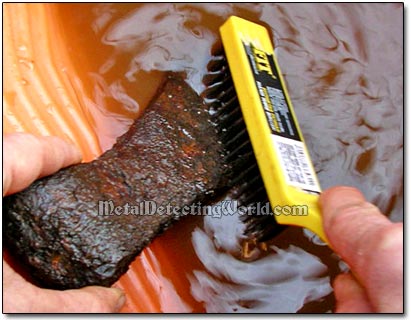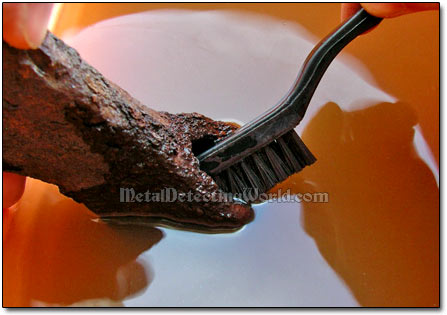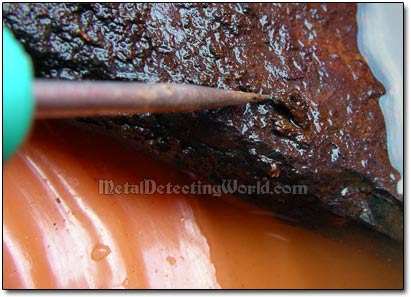Electrolytic Rust Removal - A Detailed Illustrated Tutorial, page 17
3. Preparing a Relic for Electrolysis: Mechanical Removal of Rust with Wire Brush
(...CONTINUED from Previous Page)
Prior to electrolytic rust removal, any iron artifact should be "prepared" for the process, so the process could be easily started and run without difficulties and in a cleaner container.
NOTE: Remove all non-ferrous (aluminum, copper/tin alloys, any other metals) parts from your iron object! Otherwise, these parts will be damaged (copper/tin alloys) or completely ruined (aluminum).
In case of a freshly dug iron artifact, it is recommended to place it into a hot water bath for a while, so the iron surface will not dry out, crack or scale, and the dirt, debris and excessive rust will loosen a little. The artifact should undergo this bath a few times, especially those iron pieces that have rusted in a salt-water environment (salt MUST NOT get into electrolyte!), and you need to brush the iron item with a steel wire brush between soakings until most of the dirt and loose rust comes off.
Wire Brushing Rusty Iron Artifact

Use a small Nylon brush to drive the dirt out of small enclosures such as the inside the axe butt.
Cleaning Iron Relic with Nylon Brush

If you encounter tough spots where the dirt is hardened or crusted, use an awl to remove the debris.
Using Awl for Removing Hardened Wood and Other Debris from Enclosed Space

An awl also helps in removing any loosened rust scales off the artifact's surface.
Removing Loosened Rust Layer with Awl

NOTE: While cleaning the heavy rust off the iron object, DO NOT hit the iron relic HARD with a knife, file, hammer or any metal object attempting to knock off the rust or corrosion. The thin and small iron parts right out of the damp ground are fragile and can be easily fractured, or even completely destroyed, if stricken with a hard metal object. A gentle tap on the loose scale and the rust bumps at an angle to the relic surface will knock them off.